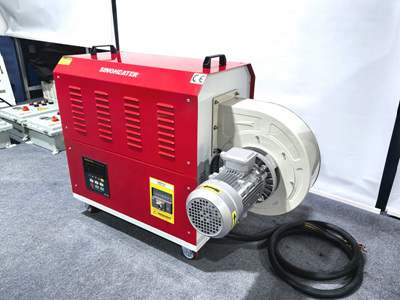First, the core value of the intelligent temperature control function
The intelligent temperature control function achieves the following key goals by monitoring the ambient temperature in real time and automatically adjusting the output power of the hot air blower:
Precise temperature control: Avoid the traditional cycle of “full power operation – overheating shutdown – temperature drop – restart” of the hot air blower to maintain a stable indoor temperature.
Energy conservation and power saving: Dynamically adjust power according to actual demand to reduce ineffective energy consumption (actual tests show that it can reduce electricity consumption by 20%-30%).
Extend service life: Reduce the wear and tear on components caused by frequent start-ups and shutdowns, and extend the service life of the equipment.
Enhance comfort: Avoid the sudden cold and hot sensations caused by temperature fluctuations, especially suitable for temperature-sensitive groups such as the elderly and children.
Second, the implementation method of the intelligent temperature control function
Accuracy of temperature sensor
High-precision sensors (with an error of ≤±1℃) can more accurately perceive the ambient temperature, avoiding temperature control lag or excessive adjustment.
Example: A certain brand of hot air blower is equipped with dual sensors (indoor + air outlet), with a temperature control error of only ±0.5℃.
Adjustment logic optimization
PID algorithm: Through proportional-integral-derivative control, it responds quickly to temperature changes and provides stable output.
Segmented regulation: Divide the power into multiple levels (such as 5 levels), and automatically switch according to the temperature difference to avoid sudden power changes.
Integration of additional functions
APP remote control: Real-time temperature viewing, target value adjustment, and even set scheduled tasks.
Intelligent scene modes: such as the “sleep mode” which automatically lowers the temperature and reduces the wind speed.
Third, purchasing suggestions: How to judge the practicality of the intelligent temperature control function
Look at the parameters
Temperature control range: Prioritize models that support a wide adjustment range of 5-35℃ to meet the demands of different seasons.
Adjustment accuracy: An error of ≤±1℃ is preferred. An error above ±2℃ may affect the experience.
Try it out
After enabling the intelligent temperature control mode, observe whether the temperature fluctuation within 10 minutes is ≤2℃.
Simulate actual usage scenarios (such as setting 25℃) and check whether the hot air blower automatically downgears after the temperature reaches the standard.
Check word-of-mouth
Refer to the user reviews on e-commerce platforms, and pay particular attention to feedback such as “whether the temperature is stable” and “whether it starts and stops frequently”.
Beware of false advertising: Some low-priced models may only support “high temperature/low temperature” two-level adjustment, but are labeled as “intelligent temperature control”. Be careful to distinguish.
Fourth, cost-performance analysis of the intelligent temperature control function
Cost increase: Hot air blowers equipped with intelligent temperature control are usually 30% to 50% more expensive than ordinary models, but they can save electricity bills in the long term.
Applicable scenarios:
High cost-performance option: For household users with high daily usage frequency (such as using it for more than 4 hours a day), the smart temperature-controlled model should be given priority.
Basic demand selection: For only temporary heating (such as short-term use in the office), a basic model of hot air blower can be chosen, but safety functions (such as overheat protection) should be noted.
Fifth, summary and recommendation
Must-have scenarios for intelligent temperature control:
Spaces such as bedrooms and baby rooms that have high requirements for temperature stability.
Scenarios of long-term continuous use in winter (such as when heating is insufficient in northern regions).
Scenarios of the optional basic model:
Temporary heating needs (such as in offices, temporary construction sites).
Users with limited budgets and insensitivity to temperature fluctuations.




